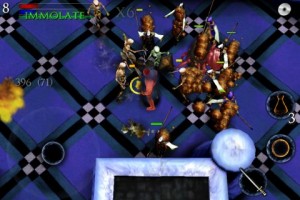 All Against One, One Against All
All Against One, One Against All
An ancient civilization built a device that grants immortality. Pretty cool, right? But like the famed Genesis Device, it also happens to double as a pretty effective weapon, and whatever went down in that defunct society wasn’t particularly good. Now every hapless adventurer who can be convinced into the mission is out to destroy The Relic (Out Now, $.99).
I mention the Genesis Device because Star Trek II: The Wrath of Khan made it patently clear that a great story could have been wrapped around a premise like this, basic as it seems. Sadly The Relic provides only the barest excuse to don the woolly beastskins of an axe-wielding barbarian who’s bent on smashing the titular device. It lies at the end of a lengthy dungeon crawl, so the player’s nameless avatar will have to hack his way through a veritable sea of foes to get there.
The Relic‘s gameplay revolves around mashing a basic attack virtual button as the player character wades into one enemy throng after another, racking up a kill tally and collecting healing potions (hopefully) faster than the player must draw on them to replenish his health gauge. Oppositionless safe areas are guarded by spirits that give the player some general direction, usually informing the barbarian that progress can be accomplished by mashing some machinery or a giant boss monster on the current floor.
 What appear to be beams of light piercing through the dungeon ceiling serve as kiosks where the player can trade in the barbarian’s kill tally for some basic upgrades and spells. Anyone hoping that this would lend the game’s combat system any more finesse will be sorely disappointed. Single-target spells shoot out of the player character with a tap of the regular attack button if he’s not in axe range, while a special attack virtual button operates on mysterious principles to determine which of the player’s accumulated area spells gets cast upon the surrounding ocean of enemies. A third virtual button invokes a shield that drains the player’s magic meter while pressed but doesn’t seem do anything interesting otherwise. With the exception of health potions attached to a fourth virtual button, most restoratives are picked up on the fly and applied to the player character’s health or magic gauge immediately; the resulting elimination of inventory management certainly makes The Relic feel streamlined, but also robbed of the satisfying complexity that might otherwise draw in Action RPG fans.
What appear to be beams of light piercing through the dungeon ceiling serve as kiosks where the player can trade in the barbarian’s kill tally for some basic upgrades and spells. Anyone hoping that this would lend the game’s combat system any more finesse will be sorely disappointed. Single-target spells shoot out of the player character with a tap of the regular attack button if he’s not in axe range, while a special attack virtual button operates on mysterious principles to determine which of the player’s accumulated area spells gets cast upon the surrounding ocean of enemies. A third virtual button invokes a shield that drains the player’s magic meter while pressed but doesn’t seem do anything interesting otherwise. With the exception of health potions attached to a fourth virtual button, most restoratives are picked up on the fly and applied to the player character’s health or magic gauge immediately; the resulting elimination of inventory management certainly makes The Relic feel streamlined, but also robbed of the satisfying complexity that might otherwise draw in Action RPG fans.
While its virtual buttons work well enough, The Relic‘s movement system is, without a doubt, the most awkward UI control element I’ve ever encountered in an iOS game. Its central control point is unforgivingly small, and yet the player must make contact with that little nub and drag appropriately to have any hope of budging his or her brawny avatar; if the player’s thumb lands anywhere else in the virtual joystick’s wide activation area, the intended movement fails to register. This is a damning flaw for a game that has exceptionally generic content otherwise, and a significant part of what makes The Relic drown hopelessly beneath the waves of competing iOS titles.
 Adding insult to injury is the bizarre way in which the game’s item collection and collision detection systems sometimes interact. Collected items apparently contain little magnets that draw them to the player character, which is fair enough; and the player character’s movement becomes sluggish if he’s asked to scrape against dungeon walls, which is fair enough. The player had better watch out if he or she sees a barrel, though! These are far more injurious to the player’s progress than enemies, because they behave as if they’re both collectible items and walls: if the player character nears a barrel it becomes immediately glued to him and slows his movement until a swing of the axe breaks it. Menu selections – to check on a Crystal achievements list or purchase upgrades at kiosks – also feel unwieldy. To the game’s credit, a quick tap on the main character summons a very nice bird’s eye view of the current dungeon floor, but it would be lovely if the player could drag it or pinch-zoom to get a better look around.
Adding insult to injury is the bizarre way in which the game’s item collection and collision detection systems sometimes interact. Collected items apparently contain little magnets that draw them to the player character, which is fair enough; and the player character’s movement becomes sluggish if he’s asked to scrape against dungeon walls, which is fair enough. The player had better watch out if he or she sees a barrel, though! These are far more injurious to the player’s progress than enemies, because they behave as if they’re both collectible items and walls: if the player character nears a barrel it becomes immediately glued to him and slows his movement until a swing of the axe breaks it. Menu selections – to check on a Crystal achievements list or purchase upgrades at kiosks – also feel unwieldy. To the game’s credit, a quick tap on the main character summons a very nice bird’s eye view of the current dungeon floor, but it would be lovely if the player could drag it or pinch-zoom to get a better look around.
The player character sports only the most basic animations, his axe swings gratingly comical to watch in motion. Similar observations could be made about his many foes. Plenty of games have squeaked by with sub-par aesthetics, but in The Relic‘s case, half baked visuals impair the player’s ability to judge what’s happening as dozens of foes descend upon his or her avatar. Tiny sprite-based characters have been knocked around or made to flash noticeably by enemy blows since the dawn of the 8-bit era, and the absence of any such indicator in The Relic reveals a little-appreciated rule of game design: health meters are nice and all, but visual feedback in all affected onscreen elements is just as necessary. The Relic‘s enemy and player character models remain stolid under the most withering onslaughts, so the player must keep a close eye on various health gauges to determine whether the protagonist is receiving damage and – more importantly – whether his attacks are having any effect on enemies.
At least The Relic‘s epic score sufficed to keep me awake enough to mash on that attack button. Musician Andy Livingston’s vocal track on the title screen, in particular, goes a long way toward imbuing the game with a distinctive melancholy; it’s just too bad the rest of the game doesn’t seize upon that vibe and make an overall compelling product.
iFanzine Verdict: Sadly The Relic seems so focused on its ability to heap dozens of enemies onscreen that it forgets some of the more basic tenets of fun gameplay. Poor movement controls and overly simplistic combat, especially, drag it well below other offerings in the dungeon crawler and Action RPG genres, leaving it difficult to recommend even within the price range. That said, it also has plenty of room to grow if developer updates shower it with lots of tender love and care.
[xrr rating=2/5]


